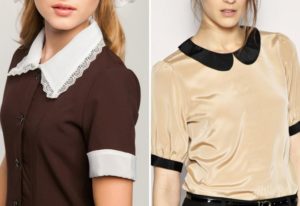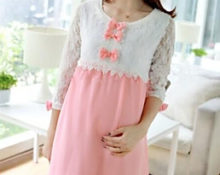 When creating a new item, most stylists place emphasis on some small details: neckline, sleeve length, cuff width or collar model. Such small details can set a particular style for a piece of clothing and indicate certain character traits of its owner.
When creating a new item, most stylists place emphasis on some small details: neckline, sleeve length, cuff width or collar model. Such small details can set a particular style for a piece of clothing and indicate certain character traits of its owner.
Recently, special attention has been paid to collars, which can revive and update even the most boring and out-of-fashion dress. Even if the outfit itself does not require its presence, a collar can be sewn if you have a pattern and small pieces of fabric on hand. Let's learn how to create a pattern yourself and sew a decoration for a dress with a round neckline.
Types of collars for dresses
Traditionally they are divided into 3 categories:
 Whole. This option does not imply a gap in the cut between the seam and the product. In most cases, one-piece collars are a small and neat extension of the top of the product.
Whole. This option does not imply a gap in the cut between the seam and the product. In most cases, one-piece collars are a small and neat extension of the top of the product.- Stitched in. Such details clearly indicate the neck line.Sewn in, they can be miniature and neat or, conversely, wide and swinging.
- Invoices. Such accessories can be purchased separately for each outfit and used as decoration. In addition, overhead collars are often sewn onto fur coats and fur coats, which allows them to be worn only when weather conditions require it.
According to the shape, a piece of clothing is divided into:
 Turndown. The flat-lying type of collar, which does not have vertical cut lines, gives the image rigor and accuracy. Flat-lying types are very convenient to decorate and use them to emphasize the beauty of the neck and chest.
Turndown. The flat-lying type of collar, which does not have vertical cut lines, gives the image rigor and accuracy. Flat-lying types are very convenient to decorate and use them to emphasize the beauty of the neck and chest.- Jabot. A slightly gathered or wide and large frill adds femininity and extravagance to the image. Most often it is sewn from light and flowing materials - tulle, chiffon, silk.
- Apache. French apache most often decorate outerwear - coats and cropped jackets. Bright scarves and stoles, matched to match the entire look, go well with them.
- Racks. Golf or Ascot - any of these types of stand-up collars look great on leather jackets, long tight dresses and sweaters.
- Fur. Soft and fluffy, in most cases they decorate outerwear. However, sometimes in the collection of a designer you can find a dress decorated with small fur details.
Which collar suits a dress with a round neckline?
For dresses with an open round neckline, a set-in Peter Pan turn-down is best." The main feature of this type is the presence of protruding rounded edges. The edges are wide in front, they narrow only towards the back.

Items decorated with a Peter Pan turn-down collar look very sophisticated. Such dresses are worn by both little girls and schoolgirls, as well as older young ladies.
Making a collar pattern for a dress
The Peter Pan pattern is very easy to make. The whole process, even for the least experienced needlewoman, will not take more than 5 minutes.
Process step by step:
- As a basis for the pattern, you will need a pattern of the main parts of the dress.
- The measurements that will be required are the sum of the neck lengths of the front and back pieces.
- The first point is placed in the upper left corner.
- From it to the right, the length of the back neck is set aside with an increase of 1 cm.
- From the original point, lay 3 cm down and put a mark. It is connected to the rightmost point of the straight segment.
- The width of the product is laid down vertically from the original point.
- A smooth bend of the lower part is laid along the formed lines.

The pattern is transferred to the fabric, not forgetting to leave some fabric for the seams.
Advice! If you need the collar to be rigid, a more stable and dense material, for example, non-woven fabric, is hemmed under the main fabric.
How to sew a collar for a dress with your own hands
Once the pattern is ready, you can proceed to sewing the collar. To do this, use the following instructions.
- The pattern must be transferred to both the main fabric and the interlining. As a result, you should get 4 parts from non-woven fabric and 4 parts of the product itself.
- The parts are glued with non-woven material.
- Having placed the parts with their front sides facing each other, they are stitched along the outer bend.
- The parts are turned inside out, thoroughly ironed and stitched along the outer curve, retreating approximately 2-3 mm from the edge.
- The inner bend line is processed using an overlocker or a zigzag stitch.
- On the dress, for which the collar is being prepared, marks are made using small pins.
- The collar is attached to the dress along the neckline.
- To securely fix the accessory, it is attached along the entire line of the neckline.
A sewn collar can be decorated with lace or braid sewn around the edges. You can attach a large brooch or a small rhinestone in the middle, which will shimmer when exposed to the rays of light.
Collar as an accessory
With the help of overhead accessories, you can make the same dress “sound differently”. Having several of these accessories on hand, you can turn a formal outfit into a festive and cheerful dress, or, conversely, add more seriousness and rigor to a youth “look.”

You can make a patch collar with your own hands:
- From the collar of an old shirt. The cut out part, which is fastened with a button, can be embroidered with rhinestones or decorated with embroidery.
- From yarn. Using knitting needles or a crochet hook, you can knit a beautiful and elegant collar that will add femininity and romance to the image.
 Made from lace. By gathering and sewing wide lace to a satin ribbon, you can get a stylish and versatile accessory that can be used to decorate clothes or as jewelry.
Made from lace. By gathering and sewing wide lace to a satin ribbon, you can get a stylish and versatile accessory that can be used to decorate clothes or as jewelry.- From beads. Collar necklaces are in great demand. For those who know how to handle beads, making such a thing will not be difficult.
A correctly selected and skillfully sewn collar can revive even the most seemingly hopeless dress. During the work process you need to be as careful and attentive as possible and then the result will not disappoint you.


 Whole. This option does not imply a gap in the cut between the seam and the product. In most cases, one-piece collars are a small and neat extension of the top of the product.
Whole. This option does not imply a gap in the cut between the seam and the product. In most cases, one-piece collars are a small and neat extension of the top of the product. Turndown. The flat-lying type of collar, which does not have vertical cut lines, gives the image rigor and accuracy. Flat-lying types are very convenient to decorate and use them to emphasize the beauty of the neck and chest.
Turndown. The flat-lying type of collar, which does not have vertical cut lines, gives the image rigor and accuracy. Flat-lying types are very convenient to decorate and use them to emphasize the beauty of the neck and chest. Made from lace. By gathering and sewing wide lace to a satin ribbon, you can get a stylish and versatile accessory that can be used to decorate clothes or as jewelry.
Made from lace. By gathering and sewing wide lace to a satin ribbon, you can get a stylish and versatile accessory that can be used to decorate clothes or as jewelry. 0
0





